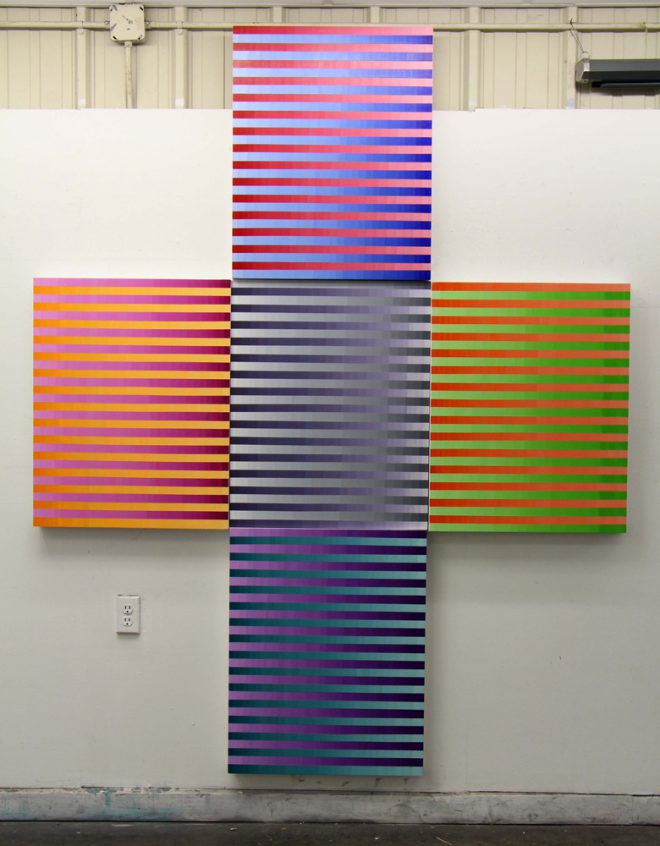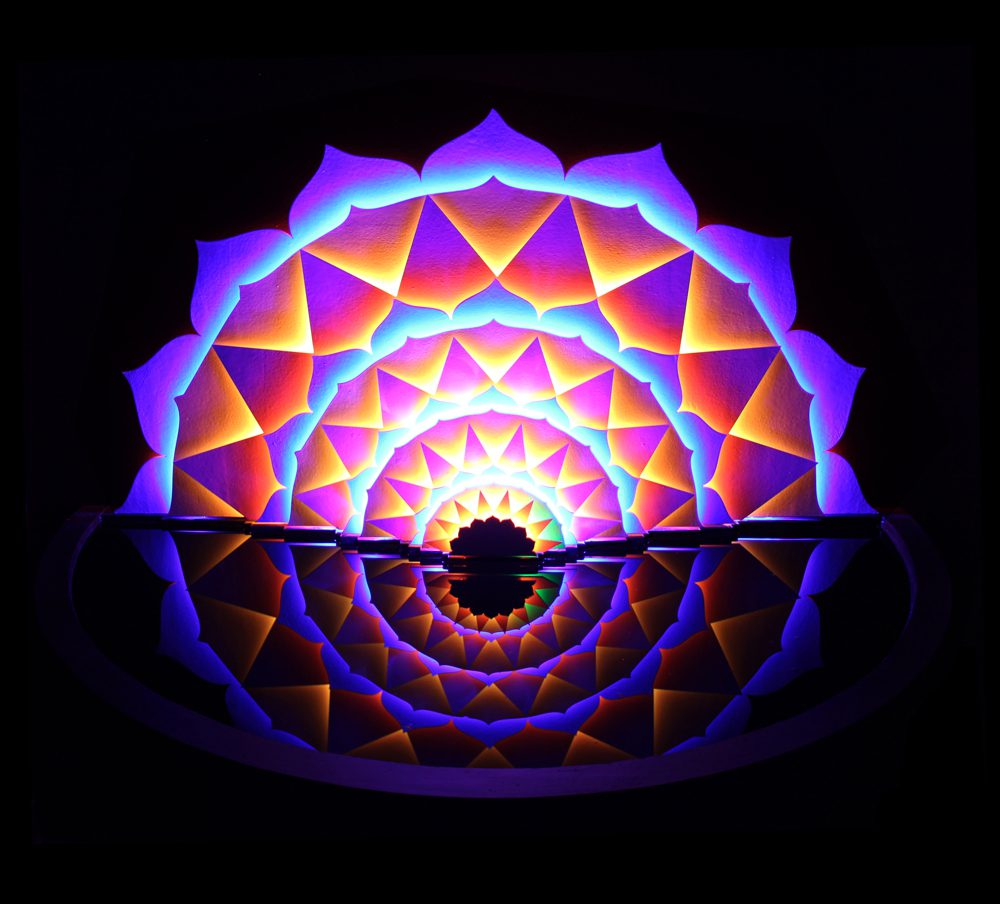Tools for Consciousness: An Interview with Martin Benson
Emily Wilkerson sits down with artist Martin Benson to discuss painting, meditation, and finding the core of one’s artistic practice.

Martin Benson, An Open Heart, 2016. Acrylic on birch panel. Courtesy the artist.
Editor's Note
Emily Wilkerson, Deputy Director for Curatorial Affairs at Prospect New Orleans, is in the process of completing her Soul School teacher training at Wild Lotus Yoga in New Orleans, where she met yoga teacher and artist Martin Benson. This March, during Benson’s MFA thesis show at UNO St. Claude Gallery, the two connected to talk about the intersections of the spiritual, the physical, and the auditory.
Emily Wilkerson: We’re here at UNO St. Claude Gallery in front of your newest body of work which is a series of colorful abstract paintings. You’ve mentioned an element of spirituality in your paintings as well as the important roles mindfulness and meditation played in developing these works. Could you talk a little bit about the title of your exhibition “Beginner’s Mind” and how these concepts inform your practice?
Martin Benson: “Beginner’s mind” is a term that was used by this great Zen teacher named Shunryu Suzuki Roshi. He has a book called Zen Mind, Beginner’s Mind. And basically, his meditative process is really a subtractive process. It’s where we are kind of digging inward and releasing the layers of identity that we’ve constructed over the years—identity that’s constructed around what other people tell us about ourselves. And so the meditation process is trying to cut through all of that—peeling layers off an onion is what a lot of people like to say. Getting down to the essence of identity.
And a lot of my work was getting so complex. I wanted to hone in on some aspects. All the unnecessary elements of symbology were distracting me from what I was really digging at. And that essence for me came down to the basic elements of art: shape, line, color, value. I started to break my previous paintings down and look at them with that simplistic approach, and then start again. And so “Beginner’s Mind” is about coming back to the beginning—seeing and experiencing something that might have been overlooked because it’s so familiar and seeing it again, as if for the first time. I was trying to mix paint like the first time I ever mixed paint. And putting colors together and trying to see them in a new light, a new way. For me “Beginner’s Mind” is just about coming back to pure awareness. Like ground zero.
EW: I’m currently reading John O’Donohue, the Celtic poet, and I really love how he describes vision. He says, “Vision is central to your presence and creativity. To recognize how you see things can bring you self-knowledge and enable you to glimpse the wonderful treasures your life secretly holds.” I’ve always enjoyed writing about contemporary art and working with artists because I think that they have the ability to draw out new ways of looking at the day-to-day in fascinating ways.
I’m curious about when your meditation practice met your painting and art-making practice, or did you always feel that they were intertwined in a way?
MB: For me, the meditative process is about being fully present and aware of all the sensations and all the experiences that are happening in the moment. And with painting, and this particular work, it’s about that quality of presence—really focusing on mixing colors and paying attention to the subtleties between colors, whether it’s through tints, tones, and shades; shifting a particular hue; or blending colors together. That became more meditative, to focus on that simplistic aspect, because a lot of the time when I was painting before I would try to get to a color really fast so I could start brushing it on the panel. But here I am really slowing down. Part of how I do that is by focusing on every little component of the process.
And when it comes to laying the paint down, each stroke of paint is like a mantra. For me, just because of my personal discipline, I actually do recite internally a mantra with each brushstroke. It’s like building, piece by piece, step by step. Letting the result make itself by paying attention to each particular step along the way. And the viewer can see that process in every little mark on the painting that builds up to create it.

Martin Benson, Crossroads, 2015. Acrylic on birch panels. Courtesy the artist.
EW: I’m glad you bring up mantras. In Sanskrit, one meaning of mantra is “mind tool.” When chanting or singing mantras, both out loud and internally, the vibrations from the sounds you’re creating can help you to tune in to your own thoughts, actions, and goals, as well as be a way for you tap into the greater world around you. Sanskrit’s emphasis on the audible nature of language comes in here. When you speak, the sounds carry as much meaning as the words themselves because there is an emphasis on how each sound creates a different vibrational direction in the mouth.
It’s really beautiful to think of these various types of movement, the auditory and vocal sensations, in relation to very physical brushstrokes, when thinking about your process. Do you recite the same mantra for every painting?
MB: Yeah. Sometimes I’m singing while I paint—it just depends on my mood. But most of the time I’m just repeating it internally over and over again, because I find that gives me focus on a particular intention. For me this is just being open—not trying to control so much, but allowing this openness to come through. It’s funny because the paintings feel so controlled.
EW: There is so much variation in color and such a presence of light in the different hues that you’re using, that openness comes out in a different way.
MB: We seem to be really attracted to light and all of its manifestations—whether it’s a dancing fire, a glowing screen, a sunset, or just the warm rays of sunlight that hit the concrete and the buildings. I love to create that sense of light in the work. And that allows the viewers to think about their presence. It’s about getting people to pay attention to the fact they’re looking at something—to pay attention to their own awareness.
EW: I’ve been thinking about the meditative process that you described in making these paintings. Do you hope that your paintings can be a tool for meditation for the viewer as well, and, if so, how does that work?
MB: Yeah, both things are happening at once. Playing with the subtle optical movement of light and these odd shapes gets people to pay attention. And the color is such an attractive element for a lot of people—we can just enjoy the color. But with those movements, my hope is that some people start to pick up on some of the subtle optical effects and then are drawn into a deeper sense of presence because they’re paying more attention to what is happening, just through looking. I’m not trying to create an intellectual exercise, but more of a phenomenological one—the subjective experience of particular stimuli.
My hope is that people spend a little more time investigating their perceptions, their viewing experiences, and also some of the subtle emotional responses that accompany those things. Because color is such an emotional trigger.

Martin Benson, Reflecting Pool, 2017. Wood, paint, LED lights, water, and soundscape. Courtesy the artist.
EW: In your Bindu series, you also focus on pattern and repetition, and I notice that a lot of Hindu gods and goddesses appear in the titles, as well as the word “dharma”—the Sanskrit term that refers to natural order, and one’s personal and spiritual evolution or to put it very broadly, one’s “purpose” in the world. Could you talk a little more about these works and your practice of creating what are referred to as yantras?
MB: That was an incredible stage for me, learning about geometry and these really fascinating symbolic shapes and proportions and how they are utilized in artworks from so many cultures—across the globe, across time. The yantra is a sacred geometric form that is associated with the Vedic tradition, which is where Hindu and yoga traditions come from. And the yantra is almost like a machine or a tool, a tool for consciousness. The symbolic forms within the yantra represent the universe, God, the One, and I think the skillfulness of the Vedic tradition is to try to compartmentalize aspects of those energies through the archetypes of the mythological figures of the gods or goddesses, which are all representations of the One’s energy that is otherwise infinite and unapproachable through conceptual thinking. So they make it more approachable.
The yantras are associated with different qualities of energy and they’re represented symbolically through specific geometry. They are used as points of meditation, for helping people to get into deeper states of consciousness. Because not everybody is willing to sit in stillness, they need something else to help guide them into those states. And the bindu is the most important part of a yantra: it is the center point. When creating a yantra, it is the last thing added because that is what basically turns the yantra on, like an on-and-off switch. It’s like the energy is activated, at least from this traditional standpoint.
EW: Do you feel that energy in the process, too, as you are creating a yantra?
MB: I’m building toward that moment of integration, where the work all becomes harmonized or integrated. The best thing for me was exploring different approaches to very precise renderings of these geometric forms—creating them in these paintings that have lots of pattern and repetition.
I look at these new works as yantras in some ways too, but more through personal expression because I felt like I could chop and screw and reuse these different traditional yantric forms—and let that geometric process become self-expression. Those are not traditional shapes at all; they’re just my playfulness—to discover what new shapes can be made and allow geometry, which tends to be more of an objective, mathematical thing, to be more expressive.
Editor's Note
Martin Benson’s MFA thesis show, “Beginner’s Mind,” was on view March 11—April 2, 2017, at UNO St. Claude Gallery (2429 St. Claude Avenue) in New Orleans.



